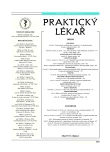-
Medical journals
- Career
Avian influenza
Authors: J. Havlík
Authors‘ workplace: Emeritní profesor I. infekční kliniky 2. LF UK, Praha
Published in: Prakt. Lék. 2005; 85(12): 681-683
Category: Reviews
Overview
Various subtypes of avian influenza viruses caused more or less extensive lethal epidemics before, affected especially gallinaceous domestic fowls. At the present time it is divided into the less pathogenic (LPAI) flu, when a part of the sick birds survive and the highly pathogenic (HPAI) flu such as A H7N7 and A H5N1, with the invariably fatal outcome. In mass infections of the poultry, there were occasionally sick persons, who were in close contact with the sick birds. Panzootic caused by the A H5N1 subtype, which increased its pathogenicity through drift changes, resulted in death of more than 100 millions of poultry. It surpassed the species barrier and caused fatal infections in other species of birds, some mammals, but severe or even fatal diseases in ten of human individuals. The transfer of infection from the sick human individuals to persons in their neighborhood was not observed. Inhibitors of neuraminidases proved to be efficient therapeutic drugs in the first two days of infection with avian influenza. In pandemic should occur, decisive prevention measure would be anti-flu vaccine prepared from the pandemic virus.
Key words:
LPAI – HPAI – pandemic – neuraminidase inhibitors – vaccine.
Labels
General practitioner for children and adolescents General practitioner for adults
Article was published inGeneral Practitioner

2005 Issue 12-
All articles in this issue
- The port and its role in oncological patients
- Avian influenza
- Hypoxia of the brain
- The power network frequency magnetic sinusoidal field and tumors of the head and throat
- Malabsorption syndrome in children, its diagnostics and treatment692
- Idiopathic macular hole - epidemiology, classification, natural course, and therapy
- The position of drospirenone in premenstrual syndrome teratment
- The position of the spa in successive care
- General Practitioner
- Journal archive
- Current issue
- Online only
- About the journal
Most read in this issue- Malabsorption syndrome in children, its diagnostics and treatment692
- Idiopathic macular hole - epidemiology, classification, natural course, and therapy
- Hypoxia of the brain
- The port and its role in oncological patients
Login#ADS_BOTTOM_SCRIPTS#Forgotten passwordEnter the email address that you registered with. We will send you instructions on how to set a new password.
- Career

